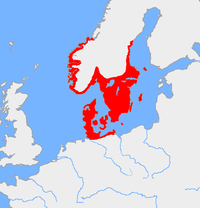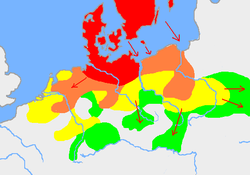Nordic Bronze Age

The Nordic Bronze Age (also Northern Bronze Age) is the name given by Oscar Montelius to a period and a Bronze Age culture in Scandinavian pre-history, ca 1800 BC - 500 BC, with sites that reached as far east as Estonia [1].
It is generally considered to be the direct predecessor and origin of Germanic culture. It succeeded the Corded Ware culture and others to evolve into the Proto-Germanic culture of the Pre-Roman Iron Age. The language that the bearers of this culture probably spoke is referred to as (pre-)Proto-Germanic.
General characteristics

Even though Scandinavians joined the European Bronze Age cultures fairly late through trade, Scandinavian sites present rich and well-preserved objects made of wool, wood and imported Central European bronze and gold. During this period Scandinavia gave rise to the first known advanced civilization in this area, following the Nordic Stone Age. The Scandinavians adopted many important European and Mediterranean symbols while adapting these to create a unique Nordic style. Mycenaean Greece, the Villanovan culture, Phoenicia and Ancient Egypt have all been identified as possible sources of influence for Scandinavian artwork from this period. The foreign influence is believed to have been due to the amber trade. Amber found in Mycenaean graves from this period originates from the Baltic Sea, so it is reasonable to assume that the culture that arose in the Nordic Bronze Age constituted one supply end of the so-called Amber Road. Many petroglyphs depict ships, and the large stone formations known as stone ships suggest that shipping played an important role. Several petroglyphs depict ships that have been identified as plausibly Mediterranean.

There are many mounds and fields of petroglyphs from the period, but their significance has long since been lost. Numerous artifacts of bronze and gold have also been found. The rather crude appearance of the petroglyphs compared to the bronze workings have given rise to the theory that they were produced by different cultures or different social groups. No written language existed in the Nordic countries during the Bronze Age. The petroglyphs have been dated as belonging to the Nordic Bronze Age by comparing depicted artifacts with archaeological finds, for example bronze axes are often portrayed in petroglyphs. The first archaeologist to make this connection was Oscar Montelius. (There are also numerous Nordic Stone Age petroglyphs, mostly portraying elk.)
The Nordic Bronze Age evolved continuously through the Pre-Roman Iron Age and the Roman Iron Age into the Germanic Iron Age and consequently both linguists and archaeologists believe that the culture of the Nordic Bronze Age and the expansion of the following Iron Age cultures corresponded to that of Proto-Germanic and the Germanic tribes.
Sub-periodization
Oscar Montelius, who coined the term used for the period, divided it into six distinct sub-periods in his piece Om tidsbestämning inom bronsåldern med särskilt avseende på Skandinavien ("On Bronze Age dating with particular focus on Scandinavia") published in 1885 which is still in wide use (For Central Europe a different system developed by Paul Reinecke is commonly used):
- I: 1800 BC-1500 BC
- II: 1500 BC-1300 BC
- III: 1300 BC-1100 BC
- IV: 1100 BC-900 BC
- V: 900 BC-600 BC
- VI: 600 BC-500 BC
These six periods are then followed by the Pre-Roman Iron Age. Another, broader subdivision is the "Early Bronze Age" between 1800 BC and 1100 BC and the "Late Bronze Age" 1100 BC to 550 BC.
Climate

The Nordic Bronze Age was characterized by a warm climate that began with a climate change in circa 2700 BC (comparable to that of present-day Mediterranean). The warm climate permitted a relatively dense population and good farming, for example grapes were grown in Scandinavia at this time. However a small change in climate between 850 BC and 760 BC and a more radical one in circa 650 BC brought in a deteriorating, wetter and colder climate (sometimes believed to have given rise to the legend of the Fimbulwinter).
It seems likely that the climate pushed the Germanic tribes southwards into continental Europe. During this time there was Scandinavian influence in Eastern Europe (and a thousand years later, the numerous East Germanic tribes that claimed Scandinavian origins (e.g. Langobards, Burgundians, Goths and Heruls) rendered Scandinavia (Scandza) the name womb of nations in Jordanes' Getica).
In fact, the Scandinavian influence on Pomerania and northern Poland from period III and onwards was so considerable that this region is sometimes included in the Nordic Bronze Age culture (Dabrowski 1989:73).
Due to the climate change and the loss of population, the Nordic countries are generally described as going through a cultural recession at the end of the Bronze Age, lasting for a thousand years until the rise of another advanced civilization in the so-called Viking Age.
Religion

Not much is known about the Nordic Bronze Age religion, since written sources are lacking. However numerous archaeological finds draw a vague picture of what the religion might have been, but possibly some sects of it and possibly only certain tribes. Some of the best clues to the religion of this period come from the rock carvings scattered through Northern Europe.
In general most scholars agree that the Bronze Age religion was centered around the sun or a sun god. The sun was carried across the sky on a wagon pulled by a horse. Rock carvings from this time period sometimes show a sun wheel (usually depicted as an equilateral cross in a circle) near or being held by a figure that seems to be male. The gender of this figure is not known with certainty, but is believed to be male because of a penis-like projection coming from the groin. It is interesting to note that while the sun seems to have been worshipped as a male figure during the Bronze Age, later Scandinavian pagan beliefs pictured the sun as a goddess (Sunna in Norse religion), and the word for "Sun" is generally attested with feminine grammatical gender in the later Germanic languages. It is unknown how this transition occurred; perhaps a merging of different cultures is the answer.
A pair of twin gods are believed to have been worshipped, and is reflected in a duality in all things sacred: where sacrificial artifacts have been buried they are often found in pairs. A female or mother goddess is believed to have been widely worshipped (see Nerthus). Sacrifices (animals, weapons, jewelry and men) have been connected to water and small lakes or ponds have often been used as holy places for sacrifice and many artifacts have been found in such locations. Hieros gamos rites may have been common. Ritual instruments such as bronze lurs have been found sacrificed and are believed to have been used in ceremonies.
Bronze Age rock carvings may contain some of the earliest depictions of well known gods from later Norse mythology. A common figure in these rock carvings is that of a male figure carrying what appears to be an axe or hammer. Most likely, this may have been an early representation of Thor. Other male figures are shown holding a spear. Whether this is a representation of Odin or Tyr is not known, as both gods are associated with this weapon. It is possible the figure may have been a representation of Tyr, as one example of a Bronze Age rock carving appears to show a figure missing a hand. A figure holding a bow may be an early representation of Ullr.
Remnants of the Bronze Age religion and mythology are believed to exist in Germanic mythology and Norse mythology, see for example Skinfaxi and Hrímfaxi, Nerthus.
Timeline of Swedish history

See also
External links
References
- Dabrowski, J. (1989) Nordische Kreis un Kulturen Polnischer Gebiete. Die Bronzezeit im Ostseegebiet. Ein Rapport der Kgl. Schwedischen Akademie der Literatur Geschichte und Alter unt Altertumsforschung über das Julita-Symposium 1986. Ed Ambrosiani, B. Kungl. Vitterhets Historie och Antikvitets Akademien. Konferenser 22. Stockholm.
- Davidson, H. R. Ellis and Gelling, Peter: The Chariot of the Sun and other Rites and Symbols of the Northern European Bronze Age.
- K. Demakopoulou (ed.), Gods and Heroes of the European Bronze Age, published on the occasion of the exhibition "Gods and Heroes of the Bronze Age. Europe at the Time of Ulysses", from December 19, 1998, to April 5, 1999, at the National Museum of Denmark, Copenhagen, London (1999), ISBN 0-500-01915-0.
- Demougeot, E. La formation de l'Europe et les invasions barbares, Paris: Editions Montaigne, 1969-1974.
- Kaliff, Anders. 2001. Gothic Connections. Contacts between eastern Scandinavia and the southern Baltic coast 1000 BC – 500 AD.
- Montelius, Oscar, 1885. Om tidsbestämning inom bronsåldern med särskilt avseende på Skandinavien.
- Musset, L. Les invasions: les vagues germanique, Paris: Presses universitaires de France, 1965.
- Nordgren, I. 2004. Well Spring Of The Goths. About the Gothic Peoples in the Nordic Countries and on the Continent.
- ^ Kinder, Hermann (1988), Penguin Atlas of World History, vol. I, London: Penguin, p. 108, ISBN 0-14-051054-0.
- ^ "Languages of the World: Germanic languages". The New Encyclopædia Britannica. Chicago, IL, United States: Encyclopædia Britannica, Inc. 1993. ISBN 0-85229-571-5.
